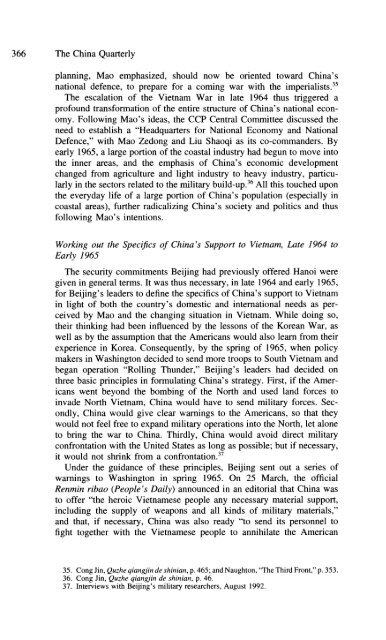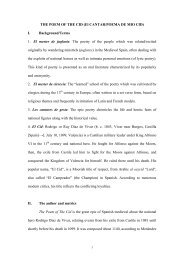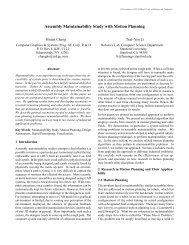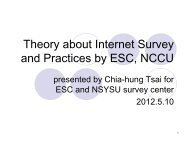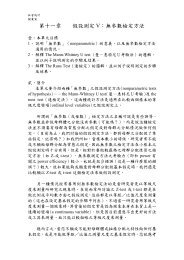366 The Ch<strong>in</strong>a Quarterlyplann<strong>in</strong>g, Mao emphasized, should now be oriented toward <strong>Ch<strong>in</strong>a's</strong>national defence, to prepare for a com<strong>in</strong>g war with <strong>the</strong> imperialists.35The escalation of <strong>the</strong> <strong>Vietnam</strong> <strong>War</strong> <strong>in</strong> late <strong>1964</strong> thus triggered aprofound transformation of <strong>the</strong> entire structure of <strong>Ch<strong>in</strong>a's</strong> national economy.Follow<strong>in</strong>g Mao's ideas, <strong>the</strong> CCP Central Committee discussed <strong>the</strong>need to establish a "Headquarters for National Economy and NationalDefence," with Mao Zedong and Liu Shaoqi as its co-commanders. Byearly 1965, a large portion of <strong>the</strong> coastal <strong>in</strong>dustry had begun to move <strong>in</strong>to<strong>the</strong> <strong>in</strong>ner areas, and <strong>the</strong> emphasis of <strong>Ch<strong>in</strong>a's</strong> economic developmentchanged from agriculture and light <strong>in</strong>dustry to heavy <strong>in</strong>dustry, particularly<strong>in</strong> <strong>the</strong> sectors related to <strong>the</strong> military build-up.36 All this touched upon<strong>the</strong> everyday life of a large portion of <strong>Ch<strong>in</strong>a's</strong> population (especially <strong>in</strong>coastal areas), fur<strong>the</strong>r radicaliz<strong>in</strong>g <strong>Ch<strong>in</strong>a's</strong> society and politics and thusfollow<strong>in</strong>g Mao's <strong>in</strong>tentions.Work<strong>in</strong>g out <strong>the</strong> Specifics of <strong>Ch<strong>in</strong>a's</strong> Support to <strong>Vietnam</strong>, Late <strong>1964</strong> toEarly 1965The security commitments Beij<strong>in</strong>g had previously offered Hanoi weregiven <strong>in</strong> general terms. It was thus necessary, <strong>in</strong> late <strong>1964</strong> and early 1965,for Beij<strong>in</strong>g's leaders to def<strong>in</strong>e <strong>the</strong> specifics of <strong>Ch<strong>in</strong>a's</strong> support to <strong>Vietnam</strong><strong>in</strong> light of both <strong>the</strong> country's domestic and <strong>in</strong>ternational needs as perceivedby Mao and <strong>the</strong> chang<strong>in</strong>g situation <strong>in</strong> <strong>Vietnam</strong>. While do<strong>in</strong>g so,<strong>the</strong>ir th<strong>in</strong>k<strong>in</strong>g had been <strong>in</strong>fluenced by <strong>the</strong> lessons of <strong>the</strong> Korean <strong>War</strong>, aswell as by <strong>the</strong> assumption that <strong>the</strong> Americans would also learn from <strong>the</strong>irexperience <strong>in</strong> Korea. Consequently, by <strong>the</strong> spr<strong>in</strong>g of 1965, when policymakers <strong>in</strong> Wash<strong>in</strong>gton decided to send more troops to South <strong>Vietnam</strong> andbegan operation "Roll<strong>in</strong>g Thunder," Beij<strong>in</strong>g's leaders had decided onthree basic pr<strong>in</strong>ciples <strong>in</strong> formulat<strong>in</strong>g <strong>Ch<strong>in</strong>a's</strong> strategy. First, if <strong>the</strong> Americanswent beyond <strong>the</strong> bomb<strong>in</strong>g of <strong>the</strong> North and used land forces to<strong>in</strong>vade North <strong>Vietnam</strong>, Ch<strong>in</strong>a would have to send military forces. Secondly,Ch<strong>in</strong>a would give clear warn<strong>in</strong>gs to <strong>the</strong> Americans, so that <strong>the</strong>ywould not feel free to expand military operations <strong>in</strong>to <strong>the</strong> North, let aloneto br<strong>in</strong>g <strong>the</strong> war to Ch<strong>in</strong>a. Thirdly, Ch<strong>in</strong>a would avoid direct militaryconfrontation with <strong>the</strong> United States as long as possible; but if necessary,it would not shr<strong>in</strong>k from a confrontation.37Under <strong>the</strong> guidance of <strong>the</strong>se pr<strong>in</strong>ciples, Beij<strong>in</strong>g sent out a series ofwarn<strong>in</strong>gs to Wash<strong>in</strong>gton <strong>in</strong> spr<strong>in</strong>g 1965. On 25 March, <strong>the</strong> officialRenm<strong>in</strong> ribao (People's Daily) announced <strong>in</strong> an editorial that Ch<strong>in</strong>a wasto offer "<strong>the</strong> heroic <strong>Vietnam</strong>ese people any necessary material support,<strong>in</strong>clud<strong>in</strong>g <strong>the</strong> supply of weapons and all k<strong>in</strong>ds of military materials,"and that, if necessary, Ch<strong>in</strong>a was also ready "to send its personnel tofight toge<strong>the</strong>r with <strong>the</strong> <strong>Vietnam</strong>ese people to annihilate <strong>the</strong> American35. Cong J<strong>in</strong>, Quzhe qiangj<strong>in</strong> de sh<strong>in</strong>ian, p. 465; and Naughton, "The Third Front," p. 353.36. Cong J<strong>in</strong>, Quzhe qiangj<strong>in</strong> de sh<strong>in</strong>ian, p. 46.37. Interviews with Beij<strong>in</strong>g's military researchers, August 1992.
Ch<strong>in</strong>a <strong>in</strong> <strong>the</strong> <strong>Vietnam</strong> <strong>War</strong>, <strong>1964</strong>-69 367aggressors."38 Four days later, Zhou Enlai made <strong>the</strong> same open announcementat a mass rally <strong>in</strong> Tirana, <strong>the</strong> capital of Albania, where he wasmak<strong>in</strong>g a formal visit.39 On 2 April, Zhou asked Mohammad Ayub Khan,Pakistan's President, to convey <strong>the</strong> follow<strong>in</strong>g message to Wash<strong>in</strong>gton:Ch<strong>in</strong>a would not <strong>in</strong>itiate a war with <strong>the</strong> United States, but Ch<strong>in</strong>a woulddef<strong>in</strong>itely offer all manner of support to <strong>the</strong> <strong>Vietnam</strong>ese; if <strong>the</strong> UnitedStates retaliated aga<strong>in</strong>st Ch<strong>in</strong>a by start<strong>in</strong>g an all-out war, Ch<strong>in</strong>a wouldmeet it; even though <strong>the</strong> United States might use nuclear weapons aga<strong>in</strong>stCh<strong>in</strong>a, Ch<strong>in</strong>a was sure that <strong>the</strong> Americans would be defeated.40 Beij<strong>in</strong>g'sleaders anticipated that Wash<strong>in</strong>gton would catch <strong>the</strong> mean<strong>in</strong>g of <strong>the</strong>semessages and, it was hoped, <strong>the</strong> expansion of <strong>the</strong> <strong>Vietnam</strong> <strong>War</strong> would berestricted.41While send<strong>in</strong>g out <strong>the</strong>se warn<strong>in</strong>gs, Beij<strong>in</strong>g's leaders were alsoprepar<strong>in</strong>g for a "worst case" scenario. On 12 April, <strong>the</strong> CCP CentralCommittee issued "Instructions for Streng<strong>the</strong>n<strong>in</strong>g <strong>the</strong> Preparations forFuture <strong>War</strong>s," a set of directives which would ultimately be relayed toevery part of Ch<strong>in</strong>ese society and become one of <strong>the</strong> most importantguid<strong>in</strong>g documents <strong>in</strong> <strong>Ch<strong>in</strong>a's</strong> political and social life for <strong>the</strong> rest of <strong>the</strong>1960s. The document po<strong>in</strong>ted out that <strong>the</strong> American imperialists wereescalat<strong>in</strong>g <strong>the</strong>ir military aggression <strong>in</strong> <strong>Vietnam</strong> and directly <strong>in</strong>vad<strong>in</strong>g <strong>the</strong>DRV's airspace, a move which also represented a serious threat to<strong>Ch<strong>in</strong>a's</strong> safety. In light of <strong>the</strong> situation, <strong>the</strong> Central Committee emphasizedthat it was necessary for Ch<strong>in</strong>a to streng<strong>the</strong>n fur<strong>the</strong>r its preparationsfor a war with <strong>the</strong> United States, and it <strong>the</strong>refore called on <strong>the</strong> Party, <strong>the</strong>Army and <strong>the</strong> whole nation to be prepared both <strong>in</strong> th<strong>in</strong>k<strong>in</strong>g and <strong>in</strong>practice for this worst possibility. To support <strong>the</strong> <strong>Vietnam</strong>ese people'sstruggle to resist <strong>the</strong> United States and save <strong>the</strong>ir country, <strong>the</strong> documentconcluded, was to become <strong>the</strong> top priority <strong>in</strong> <strong>Ch<strong>in</strong>a's</strong> political and sociallife.42 It is apparent that this document served <strong>the</strong> purpose of mobiliz<strong>in</strong>g<strong>Ch<strong>in</strong>a's</strong> military and economic potential to deal with <strong>the</strong> possible worsen<strong>in</strong>gof <strong>the</strong> <strong>Vietnam</strong> <strong>War</strong>; simultaneously it also reflected Mao's desire toradicalize <strong>Ch<strong>in</strong>a's</strong> political and social life by <strong>in</strong>spir<strong>in</strong>g a revolutionaryatmosphere at home.In <strong>the</strong> meantime, Beij<strong>in</strong>g and Hanoi were endeavour<strong>in</strong>g to achieveagreement on <strong>the</strong> specifics of Ch<strong>in</strong>ese-<strong>Vietnam</strong>ese co-operation over <strong>the</strong>escalat<strong>in</strong>g war. In early April 1965, a <strong>Vietnam</strong>ese delegation led by LeDuan, <strong>the</strong> <strong>Vietnam</strong>ese Party's first secretary, and Vo Nguyen Giap38. Renm<strong>in</strong> ribao, 25 March 1965.39. Ibid. 30 March 1965.40. Zhou Enlai's conversation with Ayub Khan, 2 April 1965, Zhou Enlai waijiao wenxuan(Selected Diplomatic Papers of Zhou Enlai) (Beij<strong>in</strong>g: The Central Press of HistoricalDocuments, 1990), pp. 436-443.41. Policy makers <strong>in</strong> Wash<strong>in</strong>gton did note <strong>the</strong>se messages, and thus felt <strong>the</strong> pressure to actwith extreme caution <strong>in</strong> attack<strong>in</strong>g <strong>the</strong> North, lest a direct confrontation with Ch<strong>in</strong>a should takeplace. See Whit<strong>in</strong>g, The Ch<strong>in</strong>ese Calculus of Deterrence, ch. 6.42. Zheng Qian, "The nation-wide war preparations before and after <strong>the</strong> CCP's N<strong>in</strong>thCongress," p. 205; Qu Aiguo, "Ch<strong>in</strong>ese supporters <strong>in</strong> <strong>the</strong> operations to assist <strong>Vietnam</strong> andresist America," p. 41; and Wang D<strong>in</strong>glie et al., Dangdai Zhongguo kongjun, p. 412.
- Page 1 and 2: China's Involvement in the Vietnam
- Page 3 and 4: China in the Vietnam War, 1964-69 3
- Page 5 and 6: China in the Vietnam War, 1964-69 3
- Page 7 and 8: China in the Vietnam War, 1964-69 3
- Page 9 and 10: China in the Vietnam War, 1964-69 3
- Page 11: China in the Vietnam War, 1964-69 3
- Page 15 and 16: China in the Vietnam War, 1964-69 3
- Page 17 and 18: China in the Vietnam War, 1964-69 3
- Page 19 and 20: China in the Vietnam War, 1964-69 3
- Page 21 and 22: China in the Vietnam War, 1964-69 3
- Page 23 and 24: China in the Vietnam War, 1964-69 3
- Page 25 and 26: Table 1: China's Military Supply to
- Page 27 and 28: China in the Vietnam War, 1964-69 3
- Page 29 and 30: China in the Vietnam War, 1964-69 3
- Page 31 and 32: China in the Vietnam War, 1964-69 3
- Page 33: China in the Vietnam War, 1964-69 3


